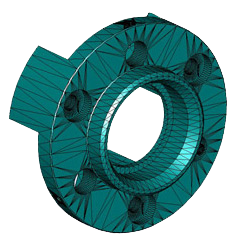Does Ashlar-Vellum Support FEA?
Ashlar-Vellum exports data to any number of Finite Element Analysis (FEA) programs. The issue is getting the data to the target program.
Graphite exports to 2D FEA programs using DXF or IGES. These FEA programs mesh the drawings themselves, breaking the geometry into tiny triangles and squares.
Cobalt, Xenon and Argon export to 2D or 3D FEA programs. The data can be handled in these FEA programs any of three ways:
- A 3D model created in Cobalt™, Xenon™ or Argon™ can be brought into the FEA program as a solid model in kernel format, such as ACIS SAT, and the FEA program creates the mesh directly on the solid model.
- A Cobalt, Xenon or Argon file can be brought in as a neutral or industry-standard 3D file, such as STEP or IGES, and the FEA program creates the mesh on the data.
- A mesh file is created mesh in Cobalt, Xenon or Argon and exported as a DXF or STL file.

Exporting an already meshed drawing can assure acceptance, but letting the FEA software do the meshing allows customized resolution and adaptive meshing. The intricacies of meshing are so important that many professionals use specialized meshing software costing upwards of US $30,000. The process runs Design → Mesh → Analyze.
FEA tools should be used by professionals trained in the strengths and weaknesses of various meshing and analysis technologies. FEA is a serious science best left to professionals using something more than the “light” FEA features built into some competitive CAD packages.